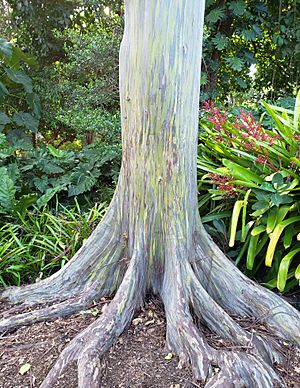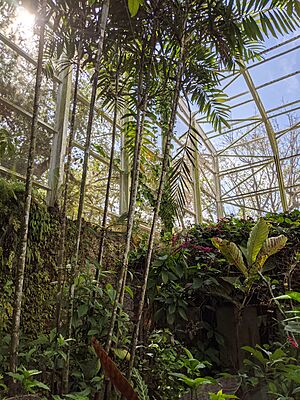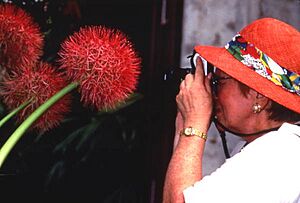Fairchild Tropical Botanic Garden facts for kids
Quick facts for kids Fairchild Tropical Botanic Garden |
|
|---|---|
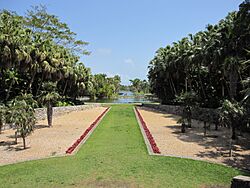
Fairchild Tropical Botanic Garden in Coral Gables, Florida
|
|
| Lua error in Module:Location_map at line 420: attempt to index field 'wikibase' (a nil value). | |
| Type | Private, open to the public for a fee |
| Location | Coral Gables, (Miami-Dade County), Florida, United States |
| Area | 83 acres (34 ha) |
| Created | 1938 |
| Status | Open year round |
Fairchild Tropical Botanic Garden is a large, 83-acre botanic garden in Coral Gables, Florida. It's home to many rare tropical plants, including palms, cycads, flowering trees, and vines. The garden is located just south of Miami, next to Matheson Hammock Park.
Fairchild opened its doors to the public in 1938. It acts as a museum, a science lab, a learning center, and a place for conservation research. Its main goal is to protect the many different kinds of plants on Earth. The garden has 45,000 members and over 1,200 volunteers who help with its important work. Since 2012, it has also been the home of the American Orchid Society.
Contents
Garden History: How It Started
The garden was created in 1936 by Robert H. Montgomery. He was a businessman who loved collecting plants. Montgomery wanted to build a botanical garden in Miami. He bought 83 acres of land along Biscayne Bay and later gave most of it to Miami-Dade County.
Montgomery named the garden after his good friend, David Fairchild. David Fairchild was a famous plant explorer. He brought more than 75,000 new plants to the United States during his travels. These included plants like mangos, alfalfa, and flowering cherry trees. Fairchild retired to Miami in 1935. Many plants still growing in the garden today were collected and planted by him, such as a giant African baobab tree.
Designing the Garden's Landscape
A man named William Lyman Phillips designed the garden. Phillips was a landscape architect who had clear ideas about how the land should look. He believed in creating variety, consistency, and contrast in his designs.
Phillips thought it was very important for the garden to feel open. He made sure that no two paths or open spaces looked exactly alike. This way, visitors would feel like they were on a journey of discovery as they explored the garden. Phillips also planned the walkways and plant spacing carefully. This helped create shaded areas, which are important in sunny South Florida.
Building the Garden Over Time
William Lyman Phillips studied landscape architecture at Harvard. He started working in Florida in 1924. By 1938, he began designing Fairchild Tropical Botanic Garden.
Many of the garden's first buildings and features were built in the first 15 years. These included the Montgomery Palmetum, the Bailey Palm Glade, and the Amphitheatre. There were also 14 lakes, stone walls, and the Montgomery Library and Museum. Over the years, more buildings were added. In 2012, a new group of buildings called the Paul and Swanee DiMare Science Village opened. This complex includes the Dr. Jane Hsaio Tropical Research Laboratories and the Clinton Family Conservatory.
Plant Collections: A World of Plants
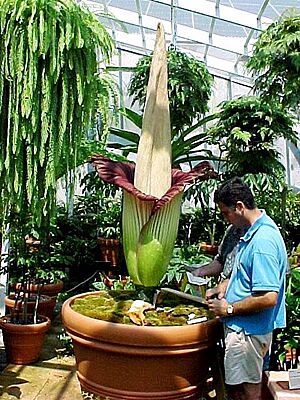
Fairchild Gardens has amazing collections of rare plants. You can find unique palms, cycads, orchids, and bromeliads here. They also have many types of ginger.
World's Largest Bamboo Collection
Fairchild has the biggest collection of tropical bamboo in the world! There are 125 different kinds of bamboo species.
Exotic Fruits and Flowering Trees
The garden also features some of the world's most exotic tropical fruits, like Durian. These fruits come from places like the Amazon, Borneo, and Thailand.
The Tropical Flowering Trees collection has over 740 species of flowering trees from all over the globe. One of the most famous is the cannonball tree. It was planted in 1938 and is known for its strong fragrance. It is one of the few cannonball trees in the United States.
The Rainforest Experience
Fairchild Garden has a two-acre rainforest with waterfalls and cascades. The plants in this rainforest were collected from the Amazon. A special misting system helps create an authentic rainforest feel.
Research and Conservation: Protecting Plants
Scientists at Fairchild work to protect tropical plants. They try to prevent species and their natural homes from disappearing. Their work helps save plants in South Florida, the Caribbean, tropical Africa, and Madagascar. They focus on plant groups like palms, cycads, tropical fruits, and tropical trees.
Fairchild works with local colleges, such as Florida International University and the University of Miami. They help train students who are studying plants and the environment.
Bringing Orchids Back to Miami
In 2014, Fairchild Gardens teamed up with the City of Coral Gables for the Million Orchid project. This project aims to bring native orchids back to Miami-Dade County. Many native orchids were lost when Miami was developed long ago. Fairchild has reintroduced three native orchid species to Coral Gables: the Florida butterfly orchid, the cowhorn orchid, and the cockleshell orchid.
Growing Plants for Space
Since 2015, Fairchild Tropical Botanic Garden has partnered with NASA’s Kennedy Space Center. They are working on the Growing Beyond Earth Challenge (GBC). This project helps scientists test edible plants that could be used for future space missions. They use special equipment that mimics conditions on the International Space Station. A small botany lab also tests plant growth using LED lights and watering systems.
Education Programs: Learning About Nature
Fairchild Tropical Botanic Garden offers many educational programs for all ages. You can learn about gardening, art, photography, and even cooking.
Programs for Kids and Teens
There are more than five educational programs for students from kindergarten to 12th grade. Through exploring the garden and doing science activities, students learn about botany (the study of plants), landscapes, and nature. These programs include the Explorer Program, Discovery Program, and Homeschool Programs.
One special program is The Fairchild Challenge. About 20,000 students from over 120 schools in Miami-Dade County participate. They plant, care for, and learn in their school gardens. The program also offers advice for school gardens and workshops for teachers.
Wings of the Tropics: Butterfly House
The "Wings of the Tropics" is a butterfly house where you can see exotic butterflies flying freely. These butterflies mainly come from Central America, South America, and Southeast Asia. The butterfly house is inside the Clinton Family Conservatory. Butterflies are released twice a day, in the morning and afternoon. You might see longwings, Morpho, and owl butterflies.
The facility has feeding stations with overripe fruits like banana and mango for the butterflies. Visitors can walk along a concrete path and watch the butterflies. Sometimes, a butterfly might even land on your shoulder or head! Special doors help make sure these butterflies stay safely inside.
Close to this conservatory, there is also an outdoor butterfly garden. Here, you can see many native butterflies, such as monarchs, zebra longwings, and julias.
Art and Festivals
Since 2003, Fairchild Tropical Botanic Garden has hosted art exhibits. Famous artists like Dale Chihuly and Yayoi Kusama have shown their work here. New art exhibits usually start each December.
The garden also holds many fun seasonal festivals on weekends. These include the International Chocolate Festival, the International Mango Festival, and the Butterfly Festival. Other events include concerts and plant society meetings. You can even buy plants during The Ramble event, which usually happens in the fall.
Events: Fun for Everyone
Fairchild Gardens hosts many events throughout the year. Some are public festivals, like "Night at the Garden" or "Very Merry Garden." These public events often have themes like music, different foods, or holidays. For example, "Sip and Stroll" events feature Jazz music while you walk through the gardens.
The "Night at the Garden" event is very popular. It fills the gardens with thousands of colorful lights and interactive displays. It's a great event for all ages and is welcoming to everyone. Fairchild Gardens also offers private events like weddings, birthday parties, or company gatherings.
See also
 In Spanish: Fairchild Tropical Botanical Garden para niños
In Spanish: Fairchild Tropical Botanical Garden para niños


